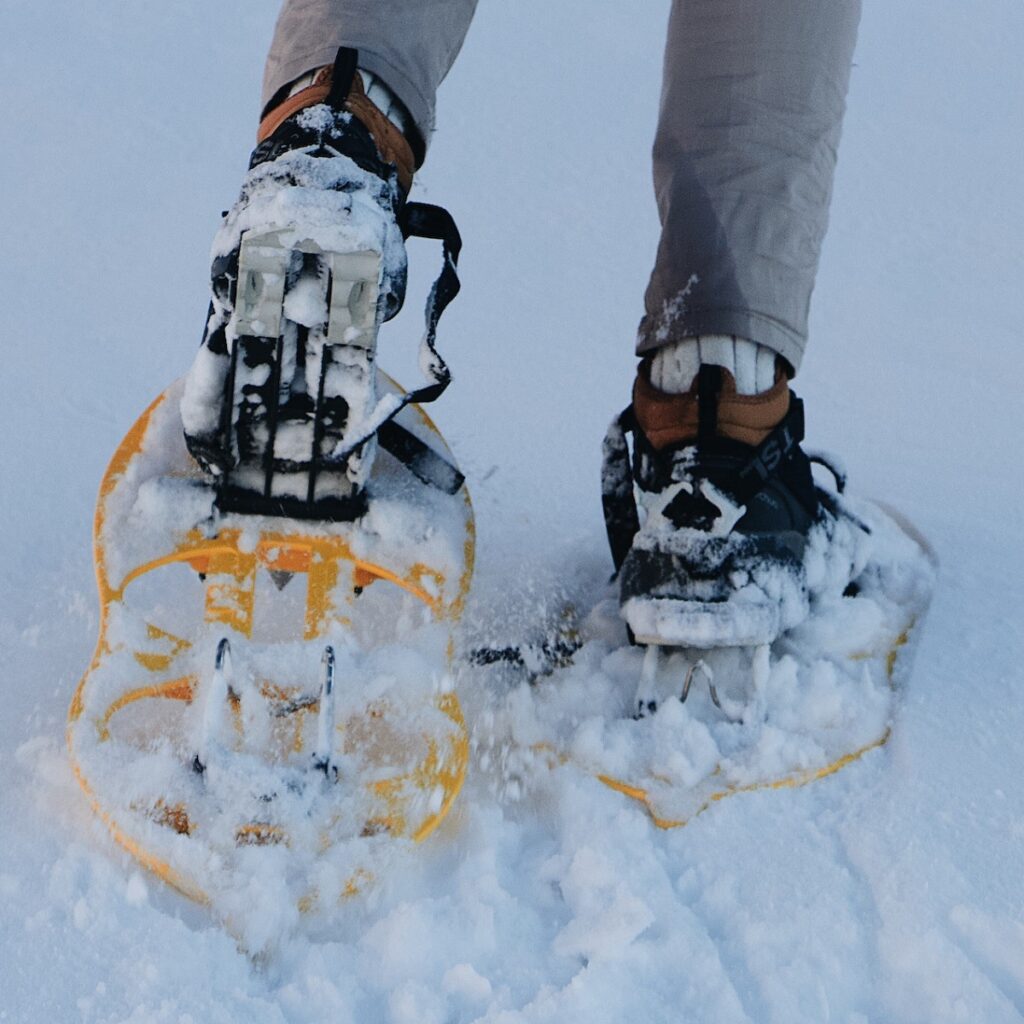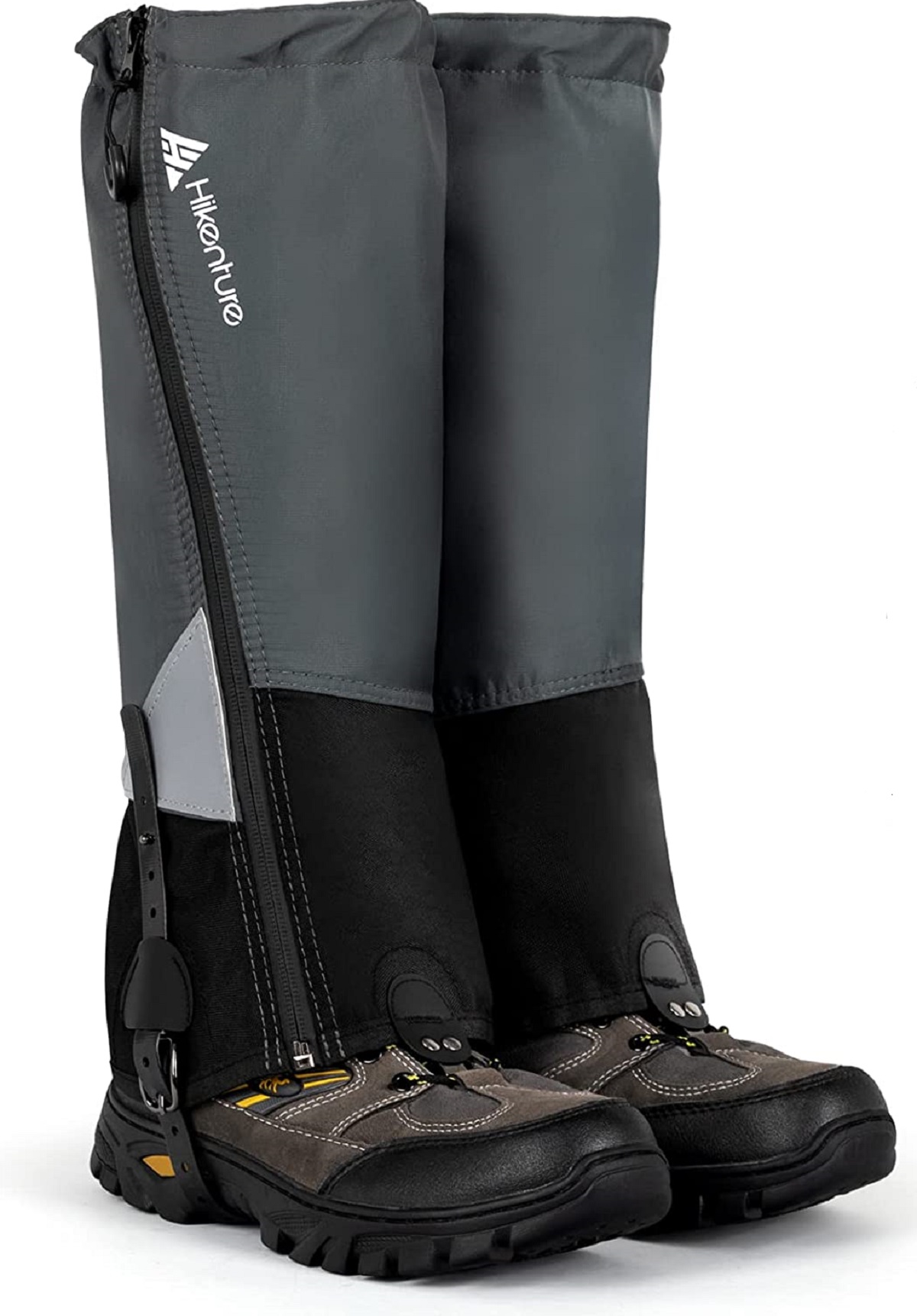Snowshoeing is a wonderful way to enjoy nature in winter. This beginners guide to snowshoeing will help you get started on the right foot!
Set your expectations + ensure you’re prepared for a rewarding adventure (vs. a snowy nightmare)
This beginners guide to snowshoeing, is packed with tips for anyone just getting started on snowshoes.

Top 4 Tips To Get Started Snowshoeing
- Make sure to find a well-traveled trail that is safe and open to snowshoeing.
- Equip yourself with the right gear (we share tips for selecting gear in this article).
- Make sure you have water and snacks for re-fueling your body along the way.
- Select the right clothing to keep you comfortable on the trail (and prepared for changing conditions).
Snowshoeing can be a memorable outdoor activity, allowing you to explore untouched snow-covered terrain under your own power. Start by considering the conditions and environment that you will be in when snowshoeing, and then use our guide to help ensure you’re prepared with appropriate gear before you head out.
Beginners Guide For Snowshoers – What You Need To Know Before You Set Out For A Snowshoeing Adventure
To get started snowshoeing, you’ll first want to identify a safe area for your first trek.
If you have access to groomed trails, that’s where we recommend you begin. A groomed winter trail will tend to be well-traveled, and you’ll be able to familiarize yourself with your equipment and will have reasonably controlled trail conditions to explore as you get comfortable.
If you’re not sure where to go, you can also look for hiking trails in your area (just make sure they are open to snowshoeing in the winter, as some may cross through dangerous avalanche areas, and will be unsafe). Nordic ski trails can also provide an option. Not all trails will be open to snowshoers, but with a little online research (or a phone call to your local Nordic Center), you’ll be pointed in the right direction.
When making your plans, be realistic about the terrain and distance you choose. Snowshoeing is much more demanding than walking, so don’t set your sights on a total distance or trail that’s too challenging for your experience level.
Next, equip yourself with some basic gear to make your journey safe and enjoyable.
To make sure you have the best possible experience, it is important to equip yourself with the right gear. Cold weather and wet snow require an investment in some basic items; insulated boots, waterproof clothing, quality socks, and a head covering or headband for extra warmth. We’ll elaborate on some tips for gear in the next section.
Don’t head out without eye protection, either. Between wind, blowing snow and the sun reflecting off the snowy trail, you’ll be very glad to have sunglasses!
Be prepared. Changing conditions and physical requirements like water and food should be part of your planning.
Carrying a comfortable, athletic backpack is wise when setting out on snowshoes. From personal items (like chapstick and sunscreen), to a water bottle or hydration pack and high energy snack options… there are lots of reasons to have extra items along with you.
You can also pack additional layers and backup dry items (like gloves) in case of unexpected or changing weather conditions.
How To Find The Best Gear For Snowshoeing
Snowshoeing is a great way to explore nature’s winter wonderland, and having the right gear can make all the difference between an enjoyable trek and a nightmare hike. When looking for snowshoeing gear, it’s important to consider your needs and experience level.
Tips For Selecting Your First Pair Of Snowshoes
For those just beginning in snowshoeing, look for shoes that are relatively lightweight to increase mobility, but provide enough traction to remain safe on the trail. Quality snowshoes should be both durable and adjustable; additionally, ensure there’s enough space for waterproof clothing underneath them.
Spend some time examining the different kinds of snowshoes available; those designed for regular or soft surface use may not provide enough traction on icier trails or steeper elevation trails.
It can be helpful to consult with experienced Snowshoers before purchasing gear to get advice on what they have found works best for the types of trails that you think you’re likely to frequent. We have rounded up some good beginner options in another article if you need help.
Tips For Selecting Proper Poles For Snowshoeing
To ensure success on the trail, you’ll want to invest in high-quality poles. A couple of things to look for are adjustable straps, and leading edges that aren’t awkward or uncomfortable to handle.
If you’re totally unfamiliar with this type of equipment, we have an article to help you find some versatile poles to get started. The right poles will make it easier to balance and will be especially useful when traveling uphill and downhill!
Beginner’s Guide To Selecting Appropriate Winter Clothing For Snowshoeing
While you might think you want to bundle up as much as possible, doing so can actually make your outing unpleasant. You’ll want to strike a balance between weatherproof outerwear that provides water and wind resistance, but is also breathable.
Trails (and conditions) can be physically demanding, so you’re likely to work up a sweat. This will keep your body warm, so dress in layers to easily adjust for conditions. The most important thing is to keep yourself warm and dry throughout your journey. Sweat can make you cold, and the cold can turn a fun adventure into a nightmare in short order.
Avoiding blisters is essential, so you’ll want to be sure you’re wearing shoes or boots that are already broken-in, as well as a pair of warm-but-thin, moisture-wicking socks. There are a few particular brands we recommend that make great options that are appropriate for many different winter sports.
Beginners Guide To Snowshoeing Gear
Essential gear to get you out on your Snowshoes with confidence should include:
- a quality pair of snowshoes, properly fitted (and adjustable)
- Comfortable and waterproof shoes (with gaiters), or snow boots
- An athletic backpack to carry extra layers and personal items including snacks and water
- thin, mositure wicking socks and a warm hat or headband
- Sun protection for your face and eyes
With these tips in mind you’ll be well on your way to getting started with Snowshoeing. It’s a life-long winter sport we hope you’ll enjoy for years to come!

